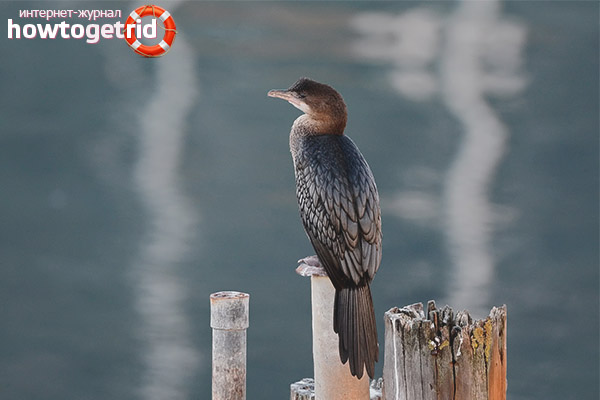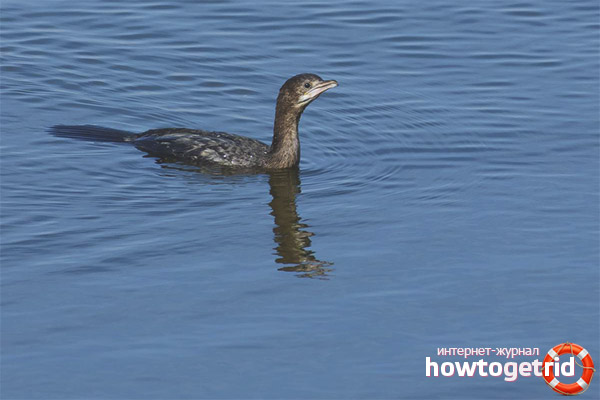The content of the article
Lesser Cormorant is the smallest representative of its kind, the bird is very shy, but beautiful and refined. Today, the small cormorant is at the stage of extinction, especially in Russian latitudes. Birds of this species are not particularly valuable for hunters, however, a large number of individuals die against the background of general environmental pollution, a significant part of the birds get stuck in fishing nets, burning of nest reeds during fires, etc. is important. What does the small cormorant look like, where does it live, and what is the bird’s lifestyle, let's try to figure it out.
The appearance of the small cormorant
The length of the average bird usually does not exceed half a meter, as noted, these are the smallest birds of the cormorant family. The wingspan of a medium-sized male is 70-80 cm, despite the fact that the wingspan of the great cormorant is almost two times larger. Black plumage with a bright mirror shine and a greenish tint favorably distinguishes individuals of small cormorants among other birds. Cormorant feathers are decorated with small white dots. The head, depending on the age of the cormorant, can be reddish or with a brown tint. The beak and neck of the small cormorant are relatively short, slightly curved. The weight of the bird usually does not exceed one kilogram, is about 700 grams. Paws and beak have a dark gray, almost black shade. During the mating season, you can notice a change in color - more white drop-shaped feathers appear.
Cormorant Habitat
Small cormorant feels great both in freshwater and in saltwater bodies of water. The main thing is that on the coast there are dense thickets of reed, shrubs or woody plants. Cormorant loves to build nests in the low parts of the reed. Particularly attractive for birds are small floating islands in the arms of the rivers with a weak current, clear water and a large number of fish.
Cormorant Lifestyle
Depending on the severity of winter in the region of residence, the small cormorant can be settled or migratory. If living conditions change and worsen, the cormorant wanders in search of new territories for nesting. The cormorants manage this easily, since the bird feels great in the air and is capable of covering huge distances in a small amount of time.
- Nutrition. The main diet of the small cormorant, like other relatives of this species, is fish. In addition, the small cormorant will not refuse to eat shrimps or amphibians - lizards, frogs, snakes. As a rule, the feathered menu consists of small fish, 10-12 cm - carp, pike, roach, rudd. Having found a good "fish" place, the cormorant will live in these areas until the amount of food begins to decrease. Sometimes cormorants can live their whole lives in one pond. If the fish becomes smaller and hunting does not satisfy, cormorants are sent to new nesting sites, in search of abundant feeding.During periods of starvation or drought, cormorants even fly into rice fields in search of food.
- Nesting. Small cormorant is monogame, forms a pair for life. Birds can live in small flocks, but, as a rule, nest with other species - large cormorants or heron. As soon as the male cormorant reaches the female, the long process of building the nest begins, in which both birds take part. They bring soft pieces of reed, leaves, twigs, reeds to make a deep semicircular nest. The bed for masonry is so trodden deep into the bushes that it is simply impossible to find eggs - not even the hatching bird is visible. The period becomes dangerous when hatched chicks begin to squeak - so they call their parents to feed them. Unfortunately, not only mom and dad can respond, but also birds of prey. The female and the male do not use the nest for one brood - if it is in good condition, the couple can lay eggs in one place for several years. As a rule, there are about 5 eggs in the clutch, which in shape resemble the eggs of a large cormorant, with the exception of size. Eggs hatch for about a month, both the female and the male participate in the process. At the end of this period, small naked chicks hatch, one parent remains next to them, the other flies to feed (in turn). In addition, you need to feed and brood - first give babies semi-digested food, which the parent belches. When the kids get stronger, they are fed small fish. And only two months later, when the chicks are fully fledged, they will begin to try themselves in flight and enjoy the "adult" food.
- Population. The number of small cormorant in Russia is according to various sources from 500 to several thousand pairs. The small cormorant is listed in the Red Book as an endangered species. An increase in the population of these birds is seen in the North Caucasus. Today around the world, explanatory discussions are held with fishers and hunters about the conservation of the small cormorant population.
You can even recognize a cormorant from afar by its characteristic pose - open wings, with which the bird flaps in the wind. So the small cormorant dries feathers after a long swim.
Interesting facts about the little cormorant
Birds of this species coexist perfectly with other birds, are not aggressive at all, hide only from predators, which are especially dangerous for a young brood. Small cormorant - the bird is not only beautiful, but also entertaining, it is interesting to watch the individuals.
- The cormorant litter, which contains a high concentration of nitrogen and phosphate, is highly regarded, which makes the composition suitable for fertilizing plants. Sometimes small cormorants are specially kept for the production of litter, which is very much appreciated by farmers. However, in densely populated places, the litter is so concentrated that he dies and literally burns all the vegetation. In some areas, a large amount of excrement has led to the death of entire forests.
- Cormorant is ruthless to fish, prevents its spawning, especially during the appearance of chicks - because the kids need a small fish that they can swallow. Against the background of a decrease in the level of commercial fishing, people began to destroy cormorants, which led to the disappearance of some species.
- Surprisingly, in China and Japan, cormorants were used for fishing. To do this, they caught large and strong individuals, put a ring on their neck, tied a rope to their paws. The bird fell into the water, easily caught fish, but could not swallow it, because it was disturbed by a ring on its neck. The bird was carefully dragged by the rope to the boat and the prey was taken out. During the night, just a couple of cormorants could catch 70-80 kg of fresh fish for a person. After such a “hunt,” the bird was naturally fed.
- Often, coastal residents use not only poultry meat and litter on the farm, but also cormorant feathers. It is believed that strong household items and beautiful jewelry for the home and body are obtained from them.
- Lesser Cormorant can be called a silent bird, since it emits characteristic sounds only during the mating season. The voice of the small cormorant is almost indistinguishable from the great cormorant.
- Usually in the wild, small cormorants live for about 6-7 years. In an artificial habitat, life expectancy increases due to the lack of starvation and predators. The longest life was recorded in the eared cormorant in captivity - it was almost 18 years old.
It is quite difficult to distinguish a female from a male cormorant, only the size of the individuals can testify to their gender — males are larger.
Today in nature there are almost two dozen varieties of cormorant, six of which can be found in the Russian strip. Small cormorant is the smallest, but one of the fastest cormorants, which flies beautifully, swims and skillfully catches fish.
Video: Cormorant (Phalacrocorax pygmeus)












Submit